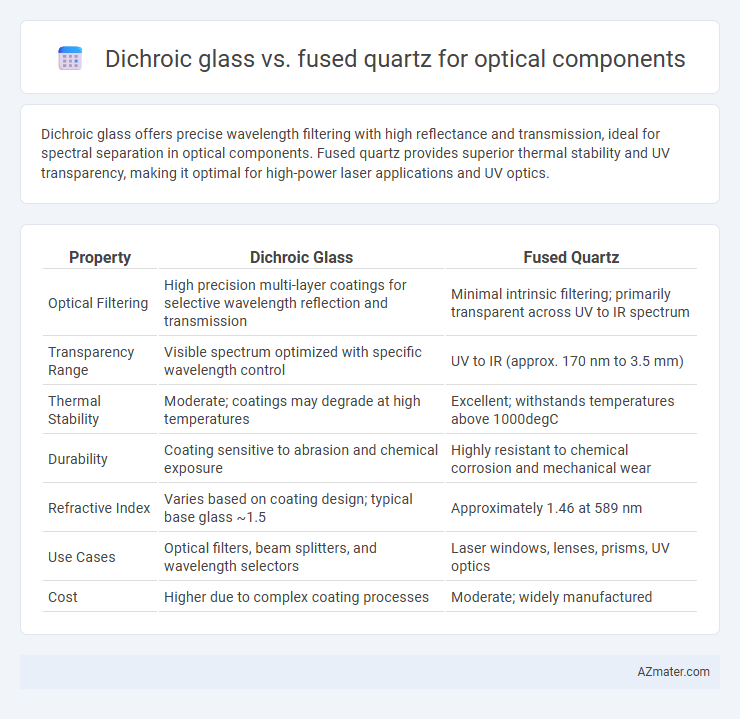Dichroic glass offers precise wavelength filtering with high reflectance and transmission, ideal for spectral separation in optical components. Fused quartz provides superior thermal stability and UV transparency, making it optimal for high-power laser applications and UV optics.
Table of Comparison
| Property | Dichroic Glass | Fused Quartz |
|---|---|---|
| Optical Filtering | High precision multi-layer coatings for selective wavelength reflection and transmission | Minimal intrinsic filtering; primarily transparent across UV to IR spectrum |
| Transparency Range | Visible spectrum optimized with specific wavelength control | UV to IR (approx. 170 nm to 3.5 mm) |
| Thermal Stability | Moderate; coatings may degrade at high temperatures | Excellent; withstands temperatures above 1000degC |
| Durability | Coating sensitive to abrasion and chemical exposure | Highly resistant to chemical corrosion and mechanical wear |
| Refractive Index | Varies based on coating design; typical base glass ~1.5 | Approximately 1.46 at 589 nm |
| Use Cases | Optical filters, beam splitters, and wavelength selectors | Laser windows, lenses, prisms, UV optics |
| Cost | Higher due to complex coating processes | Moderate; widely manufactured |
Introduction to Dichroic Glass and Fused Quartz
Dichroic glass utilizes multiple thin-film optical coatings to reflect specific wavelengths while transmitting others, providing precise control over light filtering and color separation. Fused quartz is a high-purity synthetic silica known for its exceptional optical clarity, low thermal expansion, and high resistance to UV radiation, making it ideal for high-performance optical components. Both materials serve distinct roles in optics, with dichroic glass excelling in wavelength-specific filtering and fused quartz favored for durability and broadband transparency.
Material Composition and Manufacturing Processes
Dichroic glass consists of multiple ultra-thin layers of metal oxides deposited via vacuum sputtering or evaporation onto a glass substrate, enabling selective wavelength filtering through interference effects. Fused quartz is a high-purity form of silicon dioxide (SiO2) produced by melting natural quartz or synthetic silica at temperatures above 2000degC, resulting in excellent thermal stability and optical transparency in ultraviolet to infrared ranges. Manufacturing dichroic glass requires precise thin-film coating techniques for spectral control, while fused quartz fabrication involves controlled melting and annealing processes to achieve a homogeneous and strain-free optical component.
Optical Properties Comparison
Dichroic glass exhibits precise wavelength filtering with high reflectance and transmission efficiency, making it ideal for selective color separation in optical components. Fused quartz offers superior ultraviolet transparency, low thermal expansion, and excellent homogeneity, ensuring minimal signal distortion and high durability in harsh environments. The choice depends on application-specific requirements, where dichroic glass excels in spectral control, while fused quartz provides broad-spectrum transmission and mechanical stability.
Light Transmission and Reflection Characteristics
Dichroic glass exhibits exceptional spectral selectivity with high transmission of specific wavelength bands while reflecting others, enabling precise control over light frequencies in optical components. Fused quartz offers superior broadband transmission from ultraviolet to infrared wavelengths with minimal scattering and low reflectance due to its homogenous and non-crystalline structure. The distinct difference lies in dichroic glass's multilayer dielectric coatings that manipulate light via interference, whereas fused quartz relies on intrinsic material properties for consistent transmission and low reflection across a wide spectrum.
Durability and Environmental Resistance
Dichroic glass offers excellent durability with strong resistance to scratching and chemical corrosion, making it suitable for harsh environmental conditions in optical components. Fused quartz provides superior thermal stability and exceptional resistance to high temperatures and ultraviolet radiation, ensuring longevity in extreme environments. Both materials deliver robust environmental resistance, but fused quartz excels in thermal shock and UV exposure, while dichroic glass is preferred for its mechanical hardness and chemical resilience.
Thermal and Mechanical Stability
Dichroic glass exhibits excellent thermal stability with low thermal expansion, making it suitable for precision optical filters that require minimal distortion under varying temperatures. Fused quartz offers superior mechanical stability and exceptional resistance to thermal shock due to its high melting point and low coefficient of thermal expansion, ideal for high-power laser optics and demanding environments. Both materials demonstrate robustness, but fused quartz outperforms dichroic glass in mechanical durability and extreme thermal conditions.
Application Suitability in Optical Systems
Dichroic glass is highly suitable for optical systems requiring precise wavelength filtering and beam splitting due to its multilayer interference coatings that selectively reflect and transmit specific wavelengths, making it ideal for applications like fluorescence microscopy and projection systems. Fused quartz offers superior thermal stability, low thermal expansion, and excellent UV transparency, making it preferred for high-power laser optics, UV lithography, and environments with extreme temperature variations. Optical designers select dichroic glass when sharp spectral separation is critical, while fused quartz is chosen for its durability, low optical absorption, and broad wavelength transmission in demanding systems.
Cost and Availability Considerations
Dichroic glass offers cost-effective solutions for optical components due to its mass production and widespread availability in various spectral filtering applications. Fused quartz, while more expensive, provides superior thermal stability and UV transmission, making it less commonly stocked and harder to source quickly. Budget constraints and project timelines often favor dichroic glass, whereas high-performance or specialized applications justify the higher cost and limited availability of fused quartz.
Advantages and Limitations of Each Material
Dichroic glass offers precise wavelength filtering with high spectral selectivity, making it ideal for applications requiring specific bandpass or notch filtering in optical components. Its main limitation is lower durability and potential sensitivity to environmental factors compared to fused quartz. Fused quartz provides exceptional thermal stability, high transmission across a wide spectrum, and superior mechanical strength, but it lacks the wavelength-selective filtering capabilities inherent to dichroic glass.
Choosing the Right Material for Your Optical Component
Dichroic glass offers precise wavelength filtering and high color purity, making it ideal for applications requiring selective spectral reflection and transmission. Fused quartz provides superior thermal resistance, low thermal expansion, and excellent ultraviolet transparency, suited for high-power laser and harsh environment optics. Selecting between dichroic glass and fused quartz depends on the application's spectral requirements, thermal stability, and wavelength range.

Infographic: Dichroic glass vs Fused quartz for Optical component
 azmater.com
azmater.com